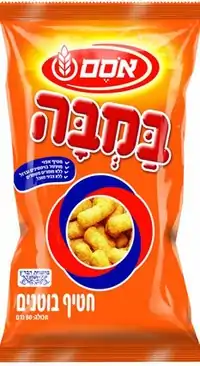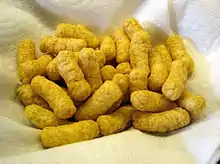Bamba (snack)
Bamba (Hebrew: במבה) is a peanut butter-flavored snack manufactured by the Osem corporation in Kiryat Gat, Israel.
 Bamba in Hebrew-language packaging | |
| Course | Snack |
|---|---|
| Place of origin | |
| Created by | Osem |
| Main ingredients | Peanuts, corn, palm oil, salt |
| Variations | Sweet Bamba, Nougat-filled Bamba, Halva-filled Bamba |
| 544 kcal (2278 kJ) | |
Bamba is one of the leading snack foods produced and sold in Israel. It has been marketed since 1964[1] with no decline in sales. Bamba makes up 25% of the Israeli snack market.[2] Similar products from other domestic manufacturers include "Parpar" (Telma, since 2000 a subsidiary of Unilever) and "Shush" (Strauss-Elite). Osem named the snack "Bamba" because it sounded like baby talk.
Overview

Bamba is made from peanut butter-flavored puffed maize. Bamba contains no preservatives or food coloring, is enriched with several vitamins, and contains high amounts of fat and salt. The energy content is 160 calories per 28 grams.[3] Bamba is certified Kosher by Badatz Jerusalem. Some describe it as "Cheez Doodles without the cheese."[4]
Manufacturing process
Corn grits are "popped" under high pressure, turning them into long lines of white, puffed, unflavored Bamba. The lines are cut into nuggets and then moved to a drying chamber where they are air-baked for 20 seconds, which gives them a crispy texture. The peanut butter, imported from Argentina, is added at the end. A worker stands on a step above the rotating drums and pours a pitcher of liquid peanut butter into each of the containers. As the drums turn, the nuggets are coated. The hot Bamba is then moved along a conveyor belt to cool before packaging.[5]
Variations
In 1964, Bamba was trialed with a cheese flavor but proved unpopular and was dropped. Osem quickly changed tack and launched Bamba in different flavors, including corn, grill, caraway and peanut butter, which became the mainstay of Bamba.
Nowadays, Osem also produces strawberry-flavored Bamba (officially called 'Sweet Bamba' Hebrew: במבה מתוקה, and unofficially 'Red Bamba' Hebrew: במבה אדומה) that is round in shape instead of oblong, and red instead of the usual color. It was originally colored with an artificial red dye, which has since been replaced with beetroot.[5] In 2008 Osem introduced a new Bamba flavor, nougat-filled, produced at the Osem plant in Sderot. It is considered by the Nestlé group, owner of the controlling interest in Osem, to be one of the great successes of Nestlé in Israel.[6] Osem introduced a halva-filled and a chocolate-filled Bamba in 2010, and a "Bamba-filled Bamba" (a peanut-butter paste filled Bamba) in 2013. In 2014 Osem introduced a special edition of Bamba and their other popular snack Bissli within the same blue package, named "Bissli-Bamba Mix", another edition of "Mix" included onion-flavor Bissli, packaged in a green pack. In 2015, 60gr bags of Bamba bomba were introduced to the market, as well as Banana Punch flavoured Bamba. Coin sized and shaped, "round Bamba" was introduced by the company In 2016, as well as a mini Bamba version of the snack called "Bambini". For Purim 2017, Osem introduced a Pretzel shaped Bamba, and towards the summer of that same year, a caramel biscuit flavoured cream filled Bamba. Ice-coffee filled Bamba was introduced in 2018, and in winter 2019 Osem introduced both Cappuccino cream filled Bamba, as well as Bamba with Chocolate.
Back in 1963 the Bahlsen company launched a very similar product to the classic Bamba called 'Erdnussflips' (peanut flips) in Germany where it remains a staple snack.
In 2017 Trader Joe's began offering Bamba under their private label, imported from Osem in Israel.[7]
Peanut allergy
As Bamba is made with peanuts, people allergic to peanuts may be severely affected by it. However early peanut consumption is associated with less prevalence of peanut allergy.[8] In fact, a 2008 study concluded that, due to the extensive consumption of Bamba by infants in Israel, peanut allergy is rare. A control group of Jewish children in the UK had ten times higher rates of allergy; the difference is not accounted for by differences in atopy, social class, genetic background, or peanut allergenicity.[9] The later Learning Early About Peanut Study (LEAP) also showed that high-risk children who were given softened sticks of Bamba in early life had a lower rate of peanut allergy later in life. Children who were exposed to peanuts through Bamba showed an 81% reduction in peanut allergy prevalence.[10]
Advertising
Bamba's advertising features the "Baby Bamba" character heavily. "Bamba Baby" is a cartoon character, depicted wearing a blue diaper. He has one tooth, and is bald except for one ginger curl at the front of his head. In honor of International Women's Day 2020, a female "Baby Bamba" was introduced. Female "Baby Bamba" wears a pink T-shirt and has pigtails.
Criticism
Some health experts say that Bamba should not be promoted as a "healthy" children's snack. They say this claim is deceptive, and the added vitamins in Bamba could result in over-consumption of nutrients.[11]
See also
- Bissli, another snack by Osem
- List of brand name snack foods
References
- Osem Archived June 27, 2012, at the Wayback Machine
- Granof, Leah (2007-01-11). "The Bisli Snack attack". The Jerusalem Post. Retrieved 2007-01-13.
Despite the apparent popularity of Bisli, the bite-sized nosh comes in decidedly second to Israel's other national pastime, Bamba, in the hierarchy of snack foods – capturing just 15% of the snack market in comparison to Bamba's 25%.
- "Calories in Osem Bamba Peanut Snack - Calories and Nutrition Facts | MyFitnessPal.com". www.myfitnesspal.com. Retrieved 2017-08-07.
- Squires, Sally. "Lean Plate Club". The Washington Post. Retrieved 2010-04-26.
- "Bamba: A little taste of Israel". Archived from the original on 2011-10-04. Retrieved 2011-10-17.
- Tsoref, Ayala (2008-12-29). "Nestlé honcho drops in the see Bamba baby, Haaretz". Haaretz.com. Retrieved 2011-10-17.
- "Is Trader Joe's 'Bamba' The Real Thing — Or A Brilliant Rip-Off?". The Forward. Retrieved 2019-09-13.
- New England Journal of Medicine:Marnie Hanel (October 22, 2015). "Letter of Recommendation: Bamba". The New York Times.
- Du Toit, G.; Katz, Y.; Sasieni, P.; Mesher, D.; Maleki, S. J.; Fisher, H. R.; Fox, A. T.; Turcanu, V.; Amir, T.; Zadik-Mnuhin, G.; Cohen, A.; Livne, I.; Lack, G. (2008). "Early consumption of peanuts in infancy is associated with a low prevalence of peanut allergy". Journal of Allergy and Clinical Immunology. 122 (5): 984–991. doi:10.1016/j.jaci.2008.08.039. PMID 19000582.
- Hindley, James P.; Filep, Stephanie; Block, Denise S.; King, Eva M.; Chapman, Martin D. (2018-02-01). "Dose of allergens in a peanut snack (Bamba) associated with prevention of peanut allergy". Journal of Allergy and Clinical Immunology. 141 (2): 780–782. doi:10.1016/j.jaci.2017.05.050. ISSN 0091-6749. PMID 28709966.
- Khromchenko, Traubmann (2007-04-06). "Peanut-flavored snacks - not as nutritious as they claim". Haaretz. Retrieved 2007-04-08.
External links
| Wikimedia Commons has media related to Bamba snack. |
- Snacks page on Osem's website (in English)